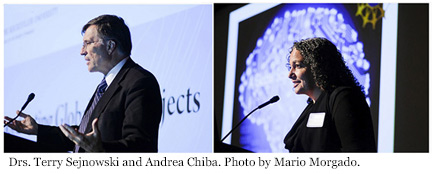TDLC scientists Drs. Terry Sejnowski and Andrea Chiba participated in an exciting Global Brain Initiative Meeting at Rockefeller University in New York on Sept. 19, 2016. The purpose of the meeting: To learn about brain projects around the world, to gather project leaders for possible future collaboration, and to prioritize projects, goals, and funding.
Over 400 participants attended the gathering. They came from diverse backgrounds that included neuroscientists, computational biologists, physicists, physicians, ethicists, and representatives from charities, private companies and national brain research initiatives. During this collaborative "meeting of the minds," Dr. Chiba spoke about the concept of a Global Science of Learning, and Dr. Sejnowski oversaw the wrap-up session.

The gathering focused on an internationally collaborative science. A worldwide interest in neurscience has been gaining momentum, with many large brain research projects being established in recent years, including the U.S. BRAIN Initiative, and Europe's Human Brain Project. China and Japan have both launched major brain initiatives, and other countries may be soon to follow. With this International interest in studying the brain comes a need to unify information and efforts, and to reconcile priorities and methods.
The Global Brain Initiative Meeting was organized by Rafael Yuste from Columbia University in New York and Cori Bargmann of Rockefeller University. Yuste explains: "Neuroscience is coming of age, and it's now ready for big science ... This is the first real meeting with all the players in the same room together." (from New Scientist)
Both the meeting organizers and the participants are hoping that this new global initiative will take neuroscience to the next level. Dr. Sejnowski sums it up: "We need to unite behind a coordinated international brain project bringing together the world's best and brightest scientists and engineers." (from New Scientist)
Additional Articles:
- Grand project to unify global efforts to understand the brain (New Scientist, 9/19/16)
- Big dreams emerge for big brain science projects (Science, 9/20/16)
- Worldwide brain-mapping project sparks excitement — and concern (Nature, 9/21/16)